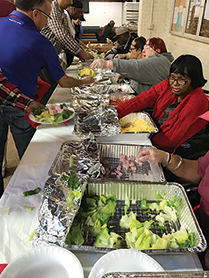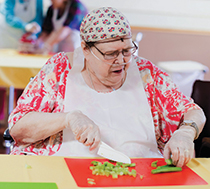
It is not uncommon to witness an increase in acts of kindness during the holiday season. Many Americans “give back” to their community by digging deeper into their pockets or volunteering their time in a shelter, for example. There is often a personal enlightenment that comes with it, and a feeling of satisfaction from knowing that one has extended oneself to another in a positive way.
What is uncommon is for this scenario to occur repeatedly throughout the entire year, involving hundreds of people with physical and/or cognitive disabilities helping thousands of other people, over and over again.
To see this in action, look no further than A Heart to Serve, a program created by Rockport Healthcare Services, which provides clinical and administrative support for skilled nursing and assisted living centers in California and Texas.
Created in 2016, A Heart to Serve encourages residents and patients, often with dementia, Parkinson’s disease, strokes, and other physical and cognitive challenges, to feed people who are homeless. Those who witness it say the process can be inspiring.
“As a clinician observing the response of residents to the A Heart to Serve program, what I saw just blew me away,” says Mike Wasserman, MD, CMD, and Rockport’s chief executive officer.
“Once they started preparing the food, cutting the tomatoes, cucumbers, and interacting with each other, their faces lit up,” he says. “And at Rockport, we’re promoting the fact person-centered care includes enhancing the individual’s purpose in life. To do that, we really need to be looking at what’s important to the person.”
Purpose-driven Living
A geriatrician who has presented nationally on purpose-driven living, Wasserman says that, for him, purpose has been a much more effective pill for treating long term care residents than any pharmaceutical that physicians currently have at their disposal.
“I like to call it the purpose pill,” he says. “If you think about it, there are very few pills that people can take that have been proven to improve how they feel overall.”
Research, which is growing, shows that having increased purpose does everything from reducing depression to improving cognitive function, he says.
Wasserman cites a National Institutes of Health study of a population of 88-year-olds that found that the more purpose they had in their lives, the less the incidence of Alzheimer’s disease. “I think that’s a phenomenal finding,” says Wasserman. “If we are improving a person’s satisfaction with life, and if we are reducing the incidents of depression, then we are probably having an impact on the clinical manifestations of Alzheimer’s disease.”
Starting Out
Matthew Lysobey, MPH, LNHA, chief community integration officer for Rockport Healthcare, remembers starting the program when he was a nursing center administrator. “We had good surveys, stable staffing, and people were motivated,” he says. “But when I looked around the facility, I saw that most of the residents were still sitting like lumps in their wheelchairs.”
Lysobey gathered his staff and asked everyone what was missing. A certified nurse assistant answered, “If I was here, and all I had to look forward to in my life was thanking other people and no one needed me anymore, I don’t care how nice everyone was to me. I would feel like a burden.”
That’s when a light went on for Lysobey. After decades as an administrator, he realized for the first time that residents are just care receivers. “We’re the caregivers, and we’re so focused on that,” he says. “But even if we’re the best of the best, if our residents feel no one needs them anymore, what reason do they have to get out of bed?”

Following up on his realization, Lysobey gathered the residents together the next day and said, “It’s time to give back to the community. What’s it gonna be?”
A 94-year-old resident raised her hand and said, “I think we should feed the homeless.”
“I thought it was a crazy idea, and, honestly, I was hoping people had other ideas,” he says, but in the end, all the residents wanted to do the same thing.
The rest is history. The residents prepared food and served it. Today, the program currently runs in all Rockport care centers.
Success Means Everything
What success means has everything to do with the residents, says Teresa Hedges, activities director at Chico, Calif.-based Windsor Chico Creek Care and Rehabilitation, the first Rockport care center to adopt A Heart to Serve’s Community Meals program.
“I’ve done other activities before that I thought were so wonderful, but with this, you can actually see that the residents feel needed.” Hedges says.
Collaboration between residents is one success. When they’re preparing the meal, she says, they work together, reminiscing about things they used to cook. It’s all about the excitement of building up to the day of serving hungry people.
Taking the role of community leader outside of the facility is another success. Residents go out in the community and provide a meal, Hedges says. “That’s one of the unique things—that we’re providing a service to the community just like other community organizations.”
From Menu to Table
During the resident council meeting, the residents will come up with a meal idea, says Hedges. They share their ideas and pick out the menu. The activities staff then give the menu to the dietary staff, who order the supplies.
The day of Community Meals service, preparing the food starts in the morning. Residents come down to the dining room and put on hair nets, gloves, and aprons. The dietary staff have all the food that needs to be prepared, wheel it in on carts, and put some music on.
“When you’re making potato salad for 150 people, it’s hard to stir,” says Hedges. “We just keep the music going, and residents tell us what needs to happen. It could be, ‘We need more celery,’ or ‘Reset the timer for the cookies.’”
If needed, Rockport gives the residents adaptive equipment. So, if a resident can only use one hand, but wants to chop up tomatoes, an automatic chopper designed for one-hand use will be provided.
Residents arrive at the shelter in the evening. At that point, staff are just standing in the background, helping residents when needed and making sure they don’t run out of food.
And all that food is donated from Rockport, every time. “It’s not a money-making thing,” says Hedges. “It’s the right thing to do.”
Feeding the Soul
But perhaps the most qualified person to talk about A Heart to Serve is Peggy Frerichs, resident of Windsor for the past 15 years. She says she’s experienced benefits from day one.
“When you’re in here—and I’ve been in here a long time—when you can give back and feel like you’re doing something more than just sitting and watching TV, it is so wonderful for your soul,” she says. “I love it because it makes me feel like a whole human being.”
Her fellow residents, she says, have changed in a positive way. “We all seem to walk a little taller because we’re doing something, we’re not just sitting in our rooms,” she says.
Frerichs warmly talks about a fellow resident who has advanced dementia. “She sure can make a mean macaroni and serve it,” Frerichs says. “Sometimes she would turn to me and say, ‘Didn’t I just do this?’
And I’ll say ‘Yep, serve another.’ But that was at the beginning. Now she says, ‘We’re gonna help the homeless, and I’m gonna make some cookies.’ That was the biggest improvement.”
Frerichs’ favorite part of it all is giving others food. “We were vibrant mothers,” she says. “We made food, we served it, and we can do it again. It’s so important to share what we have with everyone. And the homeless need us. That’s the best thing, they need me.”
Reach Amy at
ahuaiquil@providermagazine.com.